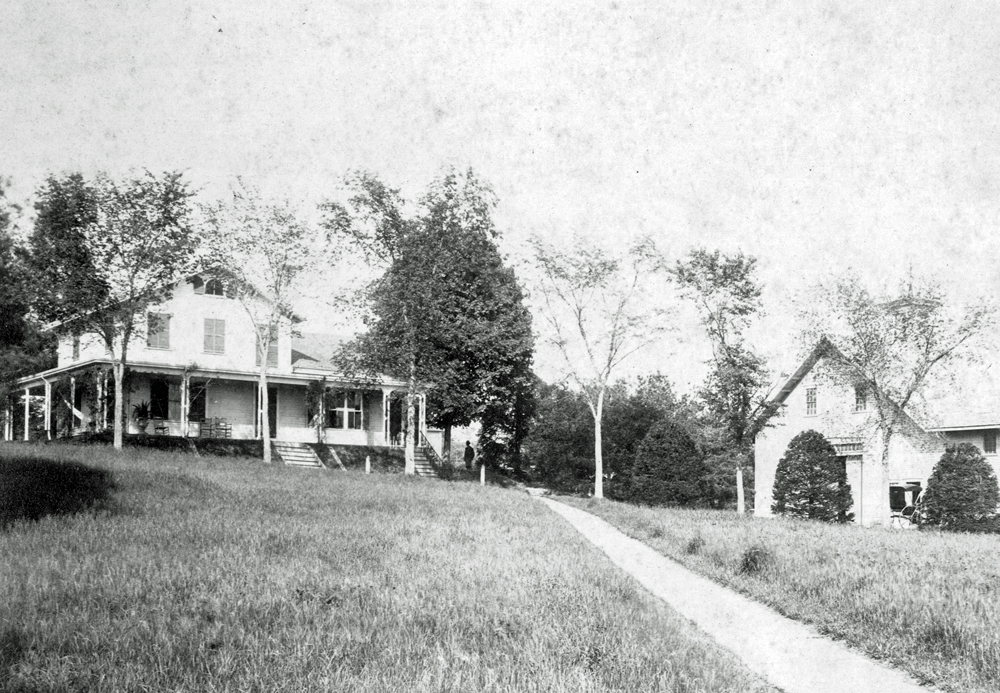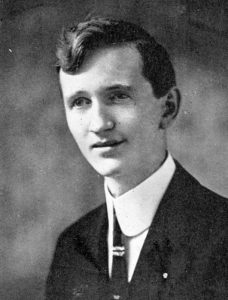True Tales from Canton’s Past: 1918 Flu Pandemic
By George T. Comeau
The home of Dr. Porter at 376 Chapman Street became the central command center for the influenza pandemic in 1918. (Courtesy of the Canton Historical Society)
It has been hard to write about historical times in Canton’s history. My editor kept poking me to get back to it, and I have thus far resisted. Well, until now. I think it has been particularly difficult because it feels like we are indeed living in a history of our own. And, as yet I’m not prepared to write an uplifting story — against a backdrop of all the tremendous pain and loss.
That said, there has been this nagging feeling of déjà vu. The term déjà vu is French and means, literally, “already seen.” Those who have experienced the feeling describe it as an overwhelming sense of familiarity with something that shouldn’t be familiar at all. And while there is no parallel with what we are experiencing today, I was drawn to a sense that Canton had historically been through this before. I was curious to see how we dealt with it and what life was like during the Influenza epidemic in 1918.
The first thing that you notice about the Canton Journal of 1918 is that the entire year’s volume is very small. Paper was at a premium as a result of shortages during World War I. The second thing that happens as you peruse the paper month to month is the enormous preoccupation with the war and how many Canton men were off in France fighting in trenches. And as September comes into view, the paper is full of stories against the backdrop of the Red Cross drives for medical supplies and the enormous Liberty Loan Campaign that raised hundreds of thousands of dollars from everyday families.
Frankly, given the descriptions today of what the epidemic was like in 1918, I was surprised at how matter of fact the coverage of the day was. Perhaps we were more resilient then, or possibly we simply accepted such ravages through the community. Whatever the case, the stories were not in depth and yet there were chilling clues that we as a community were not immune to the ravages of the epidemic. The most obvious signs were the pages and pages of obituaries.
The best description came from a public service advertisement in the Boston Globe on October 18 that helped warn people of the signs. The headline read “Help Fight the Epidemic” and described the disease as “characterized by sudden onset. People are stricken in the street, in factories, shipyards, offices or elsewhere.” The message goes on to describe the symptoms, “First there is a chill, then fever, with temperature from 101 to 103; headache, backache, reddening and running of the eyes, pains and aches all over the body and general protestation. Persons so attacked should go home and to bed and call a doctor immediately.”
There was no adequate treatment, and the prescription was fresh air and sunshine with strict orders to boil or burn all clothing and bedding associated with the sick room. Many of the men from Canton were already overseas, but even in the fall of 1918 we were still sending soldiers for training at Camp Devens, and in those close quarters, the epidemic raged. The army doctors began using dichloramine-T in a solution with eucalyptol and liquid Vaseline combined with chlorcosane — “in a prophylactic treatment as a precaution.” And while they publicly shared the treatment, they also admonished people that “no layman should attempt its use, as the ingredients are dangerous if used in improper proportions.” Breaking it down, it turns out that one of the ingredients was a popular disinfectant at the turn of the century and contained a cancer-causing “paint thinner” and solvents — much like Pine Sol, but far worse. The solution was quite toxic and was being used on young soldiers.
The first inkling of trouble in Canton came on September 25 as the Board of Health stopped all public meetings. The town treasurer, Arthur Tirrell, fell ill and a temporary treasurer was sworn in. Just like today, schools and churches as well as lodges and public spaces were closed to large groups. Nineteen deaths occurred that same week — in Canton alone. One in particular was very tragic, that of Corporal Leo Gray, who had been home in Canton for a few days on leave and died suddenly from pneumonia. That day, the town lost a good citizen and a good soldier. The loss reverberated through the community.

Cpl. Leo Gray was one of the first fatalities in Canton. (Courtesy of the Canton Historical Society)
In all the obituaries there was a common thread. In most cases the obituary read that the person had been “dangerously ill for some days and the end was not unexpected.” Just about all of the deaths happened at home. From Lawrence and Mechanic streets to Endicott and Lewis, many of the cases were concentrated downtown in the more congested heart of the town.
The epidemic brought the medical community to their knees. Within a week, nurses and doctors became ill. “On Tuesday Dr. Twomey gave out and on Wednesday night Dr. Porter was obliged to take to bed, with nerves and body completely overdone.” The rage through town was described such that “few houses have but one or more cases demanding the untiring care of someone and the death roll has grown by bounds and leaps. Wednesday there were three funerals in town and Thursday morning ten who passed away were awaiting burial.”
The numbers were staggering; in Canton that week there were 327 cases and “this number was undoubtedly smaller than the number of cases that were seriously ill.” In fact, despite what the local newspaper reported, there were at the time 700 cases, 40 of which were deathbed cases. Selectman Thomas Mullin phoned the State Board of Health and called for assistance. So dire was the request for help that Mullin boarded a train for Boston and made a visit to the State House on Beacon Hill. Within hours, two doctors and two nurses were dispatched to Canton. One of the doctors was Lionel Street of Shanghai, China. Street was about to set sail for France and instead he set off for Canton. In addition, doctors from Maryland and New York were sent to Canton.
Just as is the case today, public buildings began to be converted into makeshift hospitals. The Old High School, the Revere School on Chapman Street, and the Town Farm were all surveyed for use. Dr. C.I. Porter’s house on Chapman Street was transformed into the health center and the town was divided into districts with a nurse rotated into each district every day. Individuals were barred from calling physicians; instead all phone calls were routed through the central health center. Shades of the here and now are seen in the stories: “The doctors would work until completely overcome and then drop down for a few hours rest and again take up the burden. Unselfish the work has been done and it cannot but create a feeling of friendship and brotherly feeling among the people of the town. Many of those who have passed away were in the prime of life and have left families to be provided for. Canton will look out for her people and see they are taken care of to the limit.” That same week, there were 27 obituaries printed in the Journal.
To use the parlance of today, by mid-October the curve began to flatten after six weeks of destruction. The headlines read “Epidemic on the Wane.” During the height of the sickness, volunteers drove the doctors and nurses throughout the town. Not unlike today, ordinary citizens found ways to assist those in trouble. The domestic science teacher at the high school made gallons of soups and broths and distributed his meals throughout town. The Sisters of St. Regis Convent by day and night visited the sick to “comfort the sorrowing hearts.” And, exactly like Team Tara is doing today, dozens of people made gauze masks — which were mandatory for all folks venturing outdoors.
Over 60 friends and neighbors died that autumn. Perhaps the most poignant story of sacrifice came from the giving heart of a volunteer nurse named Mary Goodie from Oldtown, Maine. At age 21, Goodie wanted to help no matter the consequences, and arriving on the train from Boston to Canton Junction punctuated a long trip for this valiant young woman. Within a few hours of arriving in Canton the young nurse fell ill. She was taken to the Canton Hospital where she died on Friday, October 11, with her mother, Lucy, at her side. Goodie was taken home to Maine and is buried in the Riverside Cemetery in Orono. There are many forgotten heroes of 1918, and that will be the case again today. Please stay home and watch for those in need. We will get through this and Canton will be strong once more. Peace.
Short URL: https://www.thecantoncitizen.com/?p=66093










